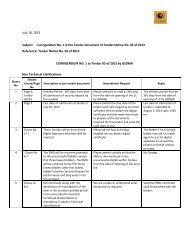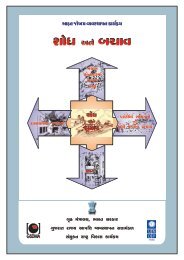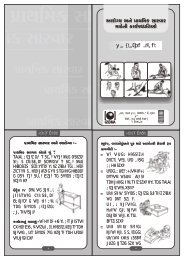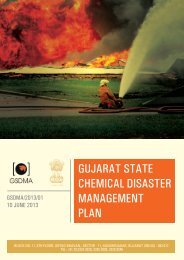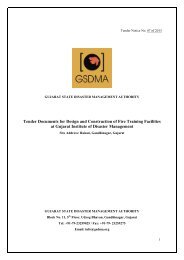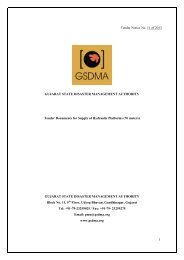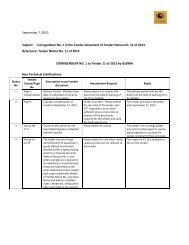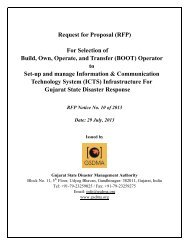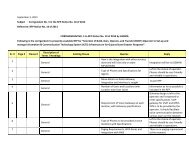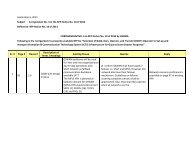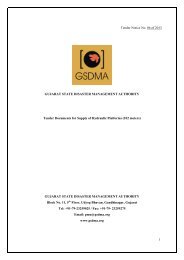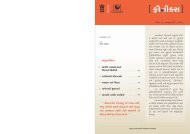Emergency Response Guidebook - Gujarat State Disaster ...
Emergency Response Guidebook - Gujarat State Disaster ...
Emergency Response Guidebook - Gujarat State Disaster ...
You also want an ePaper? Increase the reach of your titles
YUMPU automatically turns print PDFs into web optimized ePapers that Google loves.
ERG2012 USER’S GUIDEThis guidebook has been redeveloped by GSDMA as per the <strong>Gujarat</strong> context on the basis of The2012 <strong>Emergency</strong> <strong>Response</strong> <strong>Guidebook</strong> (ERG2012) . Originally, the ERG2012 was developed jointlyby Transport Canada (TC), the U.S. Department of Transportation (DOT), the Secretariat ofTransport and Communications of Mexico (SCT) and with the collaboration of CIQUIME (Centrode Información Química para Emergencias) of Argentina, for use by fire fighters, police, and otheremergency services personnel who may be the first to arrive at the scene of a transportationincident involving dangerous goods. It is primarily a guide to aid first responders in quicklyidentifying the specific or generic hazards of the material(s) involved in the incident, andprotecting themselves and the general public during the initial response phase of the incident.For the purposes of this guidebook, the “initial response phase” is that period following arrival atthe scene of an incident during which the presence and/or identification of dangerous goods isconfirmed, protective actions and area securement are initiated, and assistance of qualifiedpersonnel is requested. It is not intended to provide information on the physical or chemicalproperties of dangerous goods.This guidebook will assist responders in making initial decisions upon arriving at the scene of adangerous goods incident. It should not be considered as a substitute for emergency responsetraining, knowledge or sound judgment. ERG2012 does not address all possible circumstancesthat may be associated with a dangerous goods incident. It is primarily designed for use at adangerous goods incident occurring on a highway or railroad. Be mindful that there may belimited value in its application at fixed facility locations.ERG2012 incorporates dangerous goods lists from the most recent United NationsRecommendations as well as from other international and national regulations. Explosives arenot listed individually by either proper shipping name or ID Number. They do, however, appearunder the general heading “Explosives” on the first page of the ID Number index (yellowborderedpages) and alphabetically in the Name of Material index (blue-bordered pages). Also,the letter (P) following the guide number in the yellow-bordered and bluebordered pagesidentifies those materials which present a polymerization hazard under certain conditions, forexample: Acrolein, stabilized 131P.First responders at the scene of a dangerous goods incident should seek additional specificinformation about any material in question as soon as possible. The information received bycontacting the appropriate emergency response agency, by calling the emergency responsetelephone number on the shipping document, or by consulting the information on oraccompanying the shipping document, may be more specific and accurate than this guidebook inproviding guidance for the materials involved.BEFORE AN EMERGENCY – BECOME FAMILIAR WITH THIS GUIDEBOOK!GUIDEBOOK CONTENTS1-Yellow-bordered pages: Index list of dangerous goods in numerical order of ID number. Thissection quickly identifies the guide to be consulted from the ID Number of the material involved.This list displays the 4-digit ID number of the material followed by its assigned emergencyresponse guide and the material name.For example: ID No. GUIDE No. Name of Material1090 127 Acetone2-Blue-bordered pages: Index list of dangerous goods in alphabetical order of material name.This section quickly identifies the guide to be consulted from the name of the material involved.This list displays the name of the material followed by its assigned emergency response guide and4-digit ID number.For example: Name of Material GUIDE No. ID No.Sulfuric acid 137 18303-Orange-bordered pages: This section is the most important section of the guidebook because itis where all safety recommendations are provided. It comprises a total of 62 individual guides,presented in a two-page format. Each guide provides safety recommendations and emergencyresponse information to protect yourself and the public. The left hand page provides safetyrelated information whereas the right hand page provides emergency response guidance andactivities for fire situations, spill or leak incidents and first aid. Each guide is designed to cover agroup of materials which possess similar chemical and toxicological characteristics.The guide title identifies the general hazards of the dangerous goods covered.For example: GUIDE 124 - Gases-Toxic and/or Corrosive-Oxidizing.Each guide is divided into three main sections: the first section describes potential hazards thatthe material may display in terms of fire/explosion and health effects upon exposure. The highestpotential is listed first. The emergency responder should consult this section first. This allows theresponder to make decisions regarding the protection of the emergency response team as well asthe surrounding population.The second section outlines suggested public safety measures based on the situation at hand. Itprovides general information regarding immediate isolation of the incident site, recommendedtype of protective clothing and respiratory protection. Suggested evacuation distances are listedfor small and large spills and for fire situations (fragmentation hazard). It also directs the reader toconsult the tables listing Toxic Inhalation Hazard (TIH) materials, chemical warfare agents andwater-reactive materials (green-bordered pages) when the material is highlighted in the yellowborderedand blue-bordered pages.The third section covers emergency response actions, including first aid. It outlines specialprecautions for incidents which involve fire, spill or chemical exposure. Several recommendationsare listed under each part which will further assist in the decision making process. Theinformation on first aid is general guidance prior to seeking medical care.Page 358Page 359



